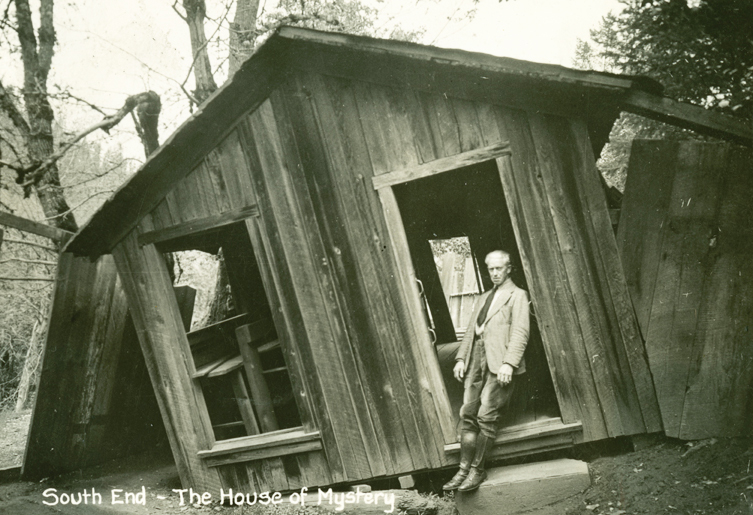After 80 years, Oregon Vortex is still keeping ’em guessing
Water seems to run uphill, and people's height appears to change from one end of a plank to another. Is it a fantastic optical illusion, or a mysterious force? Opinions vary

A man, probably John Litster, stands on the doorstep of the House of
Mystery to demonstrate its crookedness. To see several other historical
photos of the Oregon Vortex,
click here. (Image: Oregon Historical Society)
By Finn J.D. John — February 28, 2010
Downloadable audio file (MP3)
ON MARCH 1, a strange little sideways hut near Gold Hill in southern Oregon officially opened for the 2010 season – and the debate over whether it’s the scene of a baffling scientific anomaly or a clever con job will rage on into its eighth decade.
The hut is called the “House of Mystery,” and it’s part of a place known as the “Oregon Vortex.” And if you’re a serious, hard-core “The X Files” fan, you probably already know about it. It was in a 1999 episode of the cult-classic TV show.
Really, the Vortex is a prime contender for Oregon’s most successful roadside attraction, with the exception of Sea Lion Caves. Not so many years ago, there were quite a few of these, especially along Highway 101. They sported names like Prehistoric Gardens, the Sea Gulch and Trees of Mystery, and vacationing families would stop and explore them.
Most of them are gone today. But the Oregon Vortex is still popular. It’s been around since the 1930s. In it, water seems to run uphill and people’s apparent size changes from one side of a plank to another. The operators say it’s because of a confluence of magnetic influences that actually warp the fabric of space, causing massive old-growth trees to grow at a slant and objects to appear bigger or smaller depending on where they are relative to lines in the magnetic field.
The place was developed and opened in 1930 by a Scottish fellow named John Litster, a geologist and mining engineer. Litster spent much of his life trying to make sense of some of the unusual phenomena there, and developed the magnetic-force-field theory.
Litster’s theory is that the property is the site of a spherical force field, half above the ground and half below it, just under 165 feet in diameter, which causes these things.
In particular, Litster found the House of Mystery intriguing. This was an assay shack built at the Old Grey Eagle Mining Company in 1904. At some point, it apparently was knocked off its foundation by some sort of geological disruption – probably a flood – and found its way to its current spot, half collapsed sideways by its ordeal. Litster shored the wreck up to make it safe and kept it just like it was.
For decades, skeptics have scoffed. The effect of people’s heights changing have been ascribed to something called a “Ponzo illusion,” in which heavy chevron-shaped lines bracketing two identical figures cause the eye to perceive height differences in them. Also, without any horizon line or point of reference, it’s hard to really know for sure if that water really is flowing uphill in the House of Mystery.
So, is the Oregon Vortex simply a monument to 80 years of psychological suggestion and expert illusioneering? Or is there really something unusual about the place? Could there be a real scientific basis for this pseudoscientific-sounding “force field” theory?
Until a thorough scientific study is done, we can’t really know -- and the people who do thorough scientific studies tend to have higher-priority things to do than try to falsify goofy pop-sci theories that seem ridiculous on their face (as they see it).
But the operators of the Vortex have pretty much always maintained an open-door policy to the skeptics. Photographs are encouraged; skeptical investigations meet with enthusiastic cooperation and even offers of free admission to the site while investigating. It’s difficult to imagine an elaborate con job surviving this kind of openness combined with the sort of scrutiny para-normal claims always inspire, for such a long period of time, even in a relatively remote corner of southern Oregon.
Or maybe that openness is just part of the con. Either way, the place is a wonderful piece of Oregon history, and well worth checking out.
(Sources: Kershaw, Sarah. “Tourist draw for sale, with mystery the lure,” The New York Times, Sept. 19, 2003; www.oregonvortex.com; https://oregoniansforscienceandreason.org (Oregonians for Science and Reason).)
-30-













